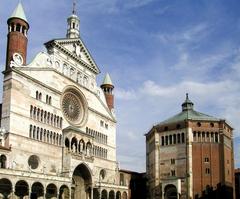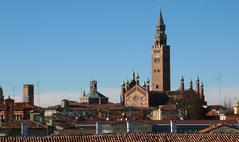
Civic Museum of Natural History Cremona: Complete Guide to Visiting Hours, Tickets, Exhibits, and Historical Insights
Date: 03/07/2025
Introduction
Nestled in Cremona’s historic center, the Civic Museum of Natural History offers a captivating encounter with the natural world and the scientific legacy of the Lombardy region. Established in the early 19th century through the pioneering collections of Marchese Giuseppe Sigismondo Ala Ponzone, the museum has evolved into a cultural beacon preserving diverse geological, botanical, zoological, and paleontological treasures. Today, it stands not only as a guardian of Cremona’s natural history but also as a vital community hub for education, conservation, and cultural engagement (Musei Comune Cremona; in-Lombardia).
Housed in the elegant Palazzo Affaitati-Ugolani Dati, the museum provides visitors with a thematic journey from ancient fossils of the Po Valley to interactive exhibits on local and global ecosystems. Its galleries, educational spaces, and family-friendly amenities make it an essential stop for scholars, tourists, and families alike. The museum’s free admission policy and central location—steps away from Cremona’s iconic Torrazzo Tower and violin workshops—make it especially accessible and appealing (Musei Regione Lombardia; WhichMuseum; Artsupp).
Table of Contents
- Discover the Museum
- Historical Background
- Visiting Hours & Admissions
- Location & Visitor Information
- Exhibition Pathways & Highlights
- Educational Mission & Community Engagement
- Nearby Attractions
- Museum Layout & Must-See Exhibits
- Accessibility & Visitor Services
- Frequently Asked Questions
- Conclusion & Next Steps
- References
Discover the Museum
The Civic Museum of Natural History in Cremona invites visitors on a journey through the region’s geological and biological past, blending scientific inquiry with hands-on educational engagement. Its thoughtfully curated collections, interactive labs, and strong community focus position it as a cornerstone of Cremona’s cultural landscape.
Historical Background
Origins
The museum was founded on the substantial collections of Marchese Giuseppe Sigismondo Ala Ponzone (1761–1842), whose vision was to create a lasting resource “for the benefit of the scholars of this city.” His bequest included minerals, fossils, zoological and botanical specimens, many of which are still displayed in their original arrangement (Musei Comune Cremona; in-Lombardia).
Expansion and Development
After Ala Ponzone’s death, the museum continued to grow through donations by local naturalists, scholars, and institutions, expanding its focus to mineralogy, paleontology, zoology, and botany. The paleontological galleries feature fossils from the Paleozoic to the Quaternary, allowing visitors to trace both global and local environmental evolution (in-Lombardia).
Recognition
In 2004, the museum achieved official regional recognition, cementing its status as a leading Lombardy institution for scientific education and heritage preservation (Musei Regione Lombardia).
Visiting Hours & Admissions
Opening Hours
- Summer (June 16 – September 16):
- Tue, Thu, Fri, Sat: 9:00–14:00
- Wed: 9:00–17:00
- Sun & Mon: Closed
- Winter (September 17 – June 15):
- Tue, Fri, Sat: 9:00–14:00
- Wed, Thu: 9:00–17:30
- Sun & Mon: Closed
Closed on major holidays, including December 25–26 and January 1 (in-Lombardia).
Admission
Admission is free. No pre-booking is required for general visits, though special events may require registration (Musei Comune Cremona).
Location & Visitor Information
- Address: Via Ugolani Dati 4, 26100 Cremona, Italy
- Phone: +39 0372 407768
- Email: [email protected]
- Official Website: Musei Comune Cremona
- Getting There: Central location; short walk from main train station. Parking available just outside the ZTL (restricted traffic zone) (Artsupp; Martha’s Italy).
Exhibition Pathways & Highlights
- Historical Gallery: Home to Ala Ponzone’s founding collection.
- Mineralogy & Petrology: Extensive display of minerals and rocks.
- Paleontology: Fossils from different geological eras, including Po Valley mammoths and marine life.
- Zoology: Evolutionary displays of local and exotic animals.
- Botany & Local Ecosystems: Focus on native plant life and ecological models.
- Entomology & Invertebrates: Butterfly, beetle collections, and microscope stations.
- Interactive Labs: Hands-on exploration for all ages.
- Temporary Exhibits: Rotating themes, such as “Relicta Loca – Abandoned Places” photography (Artsupp).
Educational Mission & Community Engagement
The museum is highly active in educational outreach, offering workshops, guided tours, and school programs. The “Aula Didattica” and the “Piccola Biblioteca” children’s library (with 10,000+ volumes) foster early scientific curiosity. Temporary exhibitions and public lectures on urban ornithology and conservation are regularly scheduled (Musei Comune Cremona).
Nearby Attractions
Within walking distance:
- Museo del Violino (Violin Museum)
- Museo Civico Ala Ponzone
- Piazza del Comune & Torrazzo Tower
These sites complement your visit, providing a full immersion in Cremona’s art, music, and science (WhichMuseum).
Museum Layout & Must-See Exhibits
Layout
The museum’s rooms are arranged for a logical, self-guided tour, taking approximately 1–2 hours.
Highlights
- Po Valley Fossils: Mammoth bones, marine fossils, plant impressions
- Local Fauna Dioramas: Padana Plain mammals and birds
- Insect Collections: Butterflies, beetles, and microscope observation stations
- Botanical Displays: Historic herbarium sheets, seed collections, and ecosystem models
- Historic Scientific Instruments: Notable for their rarity and craftsmanship
Accessibility & Visitor Services
- Full Accessibility: Step-free entrances, elevators, accessible restrooms, and tactile exhibits
- Visitor Amenities: Cloakroom, lockers (subject to availability), family-friendly educational spaces
- Languages: Italian and English signage and guides
- Photography: Allowed for personal use (no flash/tripods)
- No On-Site Café: Numerous nearby restaurants offer local cuisine (Martha’s Italy)
- Shop: Books, educational toys, and souvenirs
Frequently Asked Questions
Q: What are the museum’s opening hours?
A: See the Visiting Hours & Admissions section for up-to-date seasonal details.
Q: How much is admission?
A: Admission is free.
Q: Are guided tours available?
A: Yes, by prior arrangement.
Q: Is the museum accessible?
A: Yes, full accessibility is provided for visitors with disabilities.
Q: Can I take photos inside?
A: Yes, for personal use without flash or tripods.
Q: Are there combined tickets for other museums?
A: Yes, for the Palazzo Affaitati complex (check with staff for latest offers).
Q: Is there a café on site?
A: No, but local restaurants are nearby.
Conclusion & Next Steps
The Civic Museum of Natural History in Cremona stands as a vibrant testament to the city’s commitment to science, education, and culture. Its rich collections, engaging educational programs, and inclusive design make it a highlight for visitors of all ages. To make the most of your visit, plan ahead by checking the latest opening hours and event schedules, consider combining your trip with other Cremona attractions, and take advantage of the museum’s free admission. For personalized guides, interactive maps, and updates, download the Audiala app and follow the museum on social media.
References
- Musei Comune Cremona
- in-Lombardia
- Musei Regione Lombardia
- WhichMuseum
- Artsupp
- Artsupp event calendar
- Martha’s Italy
Suggested enhancements for digital articles:
- Include images of key exhibits with descriptive alt text (e.g., “Po Valley mammoth bones at the Civic Museum of Natural History Cremona”)
- Embed an interactive map of the museum and Palazzo Affaitati complex
- Provide links to virtual tours or educational videos, if available


